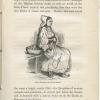Drawing of a Croatian woman
Commentary
Drawing in pencil by Arthur Evans of a woman, identified as a portrait of a Croat woman in the market place of Zagreb, Croatia.
Artist: Arthur John Evans
Date of drawing: August 1875
Continent: Europe
Geographical area: Southern Europe
Country: Croatia
Region/Place: Zagreb
Cultural group: European Croat
Format: Drawing
Size: 142 x 82 mm
Acquisition: Joan Evans. Donated August 1941
***
Exhibition caption: ‘One of a selection of drawings and ink sketches made by Arthur Evans while travelling with his brother through Bosnia and Herzegovina in the summer of 1875. They show people and places encountered by the pair on a route south from Agram (modern-day Zagreb) – via Tešanj, Sarajevo and Mostar – to Ragusa (Dubrovnik), which Evans and his wife were later to make their home. The illustrations demonstrate a particular interest in identity and dress, Evans writing, for example, of finding “two Bulgarians hard at work tying up bundles of onions, clad in their dark national costume – the brown tight-sleeved jacket embroidered with black, the dull red sash, the brown trowser-leggings which are equally Turkish and Tartar and on their head the black sheepskin cap which had at first attracted my attention.” As well as being an aide-mémoire, the drawings provided the basis for engravings published in Evans’ account of his journey, Through Bosnia and the Herzegóvina on Foot during the Insurrection, August and September 1875 (London, 1876). As an eyewitness account of a distant region in turmoil, the book was an immediate success, quoted extensively in Parliament, and it went into a second edition the following year.’ Source: ‘Travels in Finland and Bosnia-Herzegovina: An Ethnographic Collection of Sir Arthur Evans’, exhibition curated by Philip Grover, Pitt Rivers Museum, University of Oxford, 29 April to 1 September 2013.
Primary documentation: ‘[p.588] Dr. JOAN EVANS, from the property of the late SIR ARTHUR EVANS, Youlbury, Boars Hill, Oxford. [List of items follows]’; ‘[p.590] 21 Original pencil sketches, types & scenery. BALKANS’: Pitt Rivers Museum accession records (Donations X, 1937–1941), pp.588, 590. Annotations on drawing: ‘Croat/ In Agram’ (written in pencil below drawing).
Research notes: It has been identified by Philip Grover that this original drawing was used as the artwork for a woodcut engraving subsequently published in Arthur J. Evans, Through Bosnia and the Herzegóvina on Foot during the Insurrection, August and September 1875 (London, 1876), p.9, printed with the caption ‘Croat Woman in the Agram Market’. Evans recorded in the volume: ‘The market place is a spacious studio. The beauty of the Croatian peasant costume is almost unique in Europe - possibly only rivalled at Belgrade. [...] In the Agram market-place, not only the colours, but the very materials, might have been chosen by an artist. [...] The head-dresses of these village ladies are varied, for every hamlet has its speciality of costume. [...] On some, from St. Ivan, the transparent white kerchief falls about the bust and shoulders lightly as a bridal veil; on others it takes a rosier hue, and is known as the Rubatz. On others, again, as those from Zagoria - who will have it that they are great grand-daughters of Avars - it is drawn backwards over a long silver pin, stuck horizontally across the hair, and depends over the back till its variegated border and long fringe sweep the girdle. [...] In place of a skirt they generally wear two wide overlapping aprons, one before and one behind, which in a gale of wind may afford occasional studies for a Bacchante ! and over the front one of these hangs a narrower apron starred with red asterisks, crossed by little zigzagging patterns, or by light transversal bands of rose and lilac. But enough of such pallid hues! The pride of their toilette is a brilliant crimson scarf, the Pojas, wound round the waist, some of the folds of which are at time loosened and hang down over the front apron in a graceful sing or outside pouch. [...] Round their necks hangs an array of what politeness would have me call coral necklaces. Occasionally they wear silver ear-rings, silver pendants on their breast, and rings on their fingers’: Through Bosnia and the Herzegóvina on Foot, pp.7, 8, 9–10. Note that Agram is the German name for Zagreb, Croatia.

